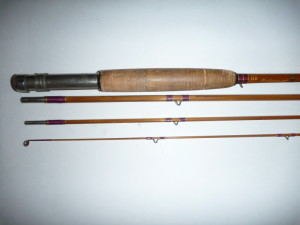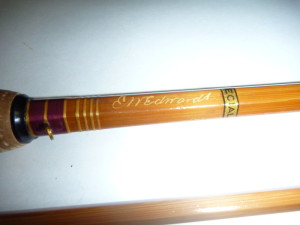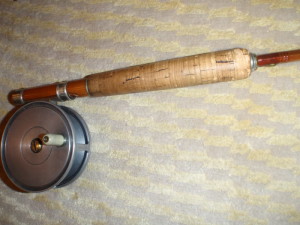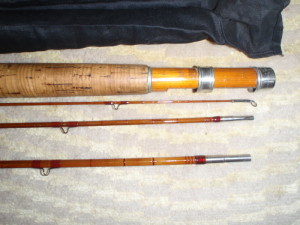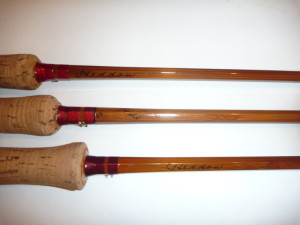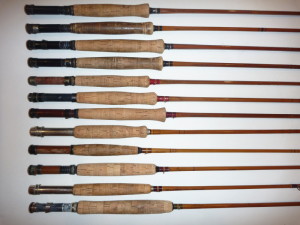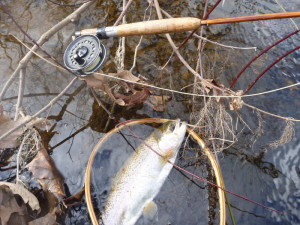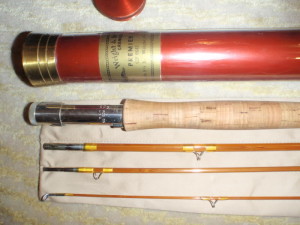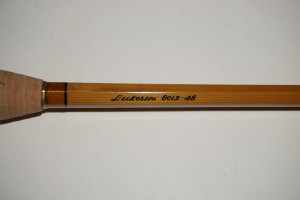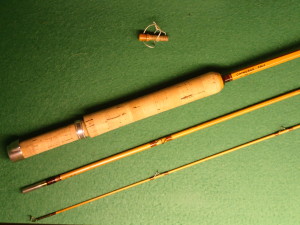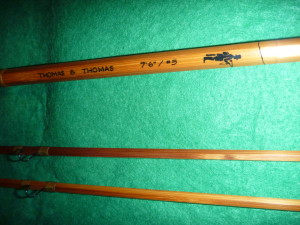Fly fishing goes back to ancient times, but “modern” fly rods began appearing in the 19th century. Early rods were made of wood, including ash, lancewood and greenheart, but the ongoing quest to make the lightest, strongest tips led to a number of innovations, including tips made from whalebone. Tip sections made from bamboo began to gain favor, with the cane being “rent” into strips that were then glued back together, making a strong yet light and flexible tip. Tips could be four, six or even eight strips. Six strips eventually became the norm.
There is disagreement over who made the first complete, six-strip bamboo rod in America, but credit has been given to both Samuel Phillipe of Easton, Pa., and Charles Murphy of Newark, N.J. Both were making rods around the time of the Civil War. Phillipe’s son Solon, a Union Army veteran, continued making rods after his father’s death.
In the 1870s, Hiram Leonard, a gunsmith, hunter and hunting guide in Maine, began making bamboo rods. As demand for his rods grew, he invented a beveler to cut uniform strips, which reduced labor and time, revolutionizing the industry and making possible the mass production of high-quality rods. Not coincidentally, in these last decades of the 19th century, middle-class and wealthy urbanites became drawn to the outdoor “sports,” focusing on hunting and fishing for pleasure instead of for sustenance. Companies like Abercrombie & Fitch, William Mills and Von Lengerke & Antoine provided a retail outlet for the fine bamboo rods now being turned out by Leonard and other rodmakers.
After the William Mills sporting goods firm in New York gained control of Leonard’s company, it moved from Maine to Central Valley, N.Y., where it turned out to be an incubator for rodmaking talent. As was the case in the aircraft and auto industries in the 20th century, and the computer and information industries today, teams of brilliant young workers, some of them destined to become leaders in their fields, not only crafted the everyday products increasingly sought by affluent consumers, they also innovated, experimented and reinvented. By the late 1890s, some of the best young men at Leonard had left to form new companies, sometimes working together, sometimes alone. E.F. Payne, F.E. Thomas, E.W. Edwards and H.W. Hawes worked together off an on, and collaboration included the stunning Kosmic rod with its ivoroid reel seat and distinctive ferrules.

U.S. Net & Twine Kosmic and Philbrook & Paine fly reel. Ed Payne’s name was misspelled on these reels. The patent was assigned to Hiram Leonard, Payne’s employer. Payne was one of the Leonard employees who left to work on the Kosmic and eventually formed their own companies.
Click on any image to enlarge
The Kosmic label, under the original sponsorship of baseball great Albert Spalding and his giant sporting goods company, then under U.S. Net & Twine of Brooklyn and finally the Whittemore company of Boston, continued into the 20th century. Fred E. Thomas is believed to have retired the Kosmic brand eventually, but he also turned out a long line of other excellent trout and salmon rods that continued to be made under his and his son’s supervision until the company finally shut its doors in 1958.
Ed Payne also formed his own company, and after his death in 1914 his son, James, took over, continuing to make Payne rods until his death in 1968. Payne rods were renowned for their smooth finish, jewel-like metal work and smooth actions. Many experts and collectors today believe Jim Payne was the greatest fly rod maker ever.
Eustis W. Edwards, a peripatetic rodmaker/metalworker/photographer who came into and out of the bamboo rod business over a series of decades, began making his own rods in Bangor, Maine, after leaving Central Valley. He sold his brand (and his services) to Winchester in the 1920s, and after his contract with the gunmaker was up, he made his own rods in various locations in Connecticut until he died in 1931, shortly after selling his company, again, to the Horton Manufacturing Company of Bristol, Conn. His sons, Gene and Bill, worked for Bristol for a few years, but each ended up running his own company, making superb rods into the 1950s. Bill Edwards focused on the distinctive “quad,” a four-section rod in perfect square profile that combined ease of production with robust strength and, quad aficianados insist, more accurate casting qualities. Gene made high-quality rods under his own name and many more production rods that were labeled for other companies, including Weber, L.L. Bean and Shakespeare.
Hiram Hawes, a nephew of Hiram Leonard, married the boss’s daughter and made elegant rods in Connecticut, with the company continuing under Hiram’s own son after his death.
As for Hiram Leonard, long before his death in 1907, the old woodsman had lost control of his company to the Mills operation, which continued to operate Leonard well into the late 20th century. A major fire in 1964 was a setback, but the company survived, thanks to talented rodmakers like Ted Simroe and Tom Maxwell, continuing to innovate, only to change hands, eventually fall into receivership — and finally to be sold for back taxes.
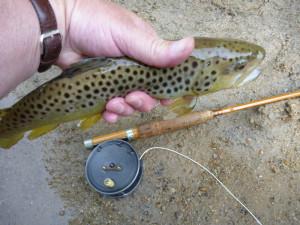
7 1/2-foot Leonard 49 rod with a 1920s-era reel made by Dingley in England, and a brown trout caught in the Wood River in Rhode Island.
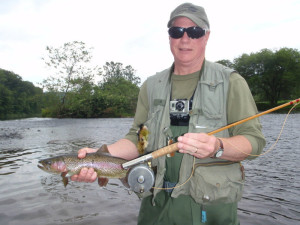
1930s-era Leonard 50 1/2, an 8 1/2-foot rod, on the West Branch of the Delaware River in upstate New York. The reel is a Dingley Perfect made in England.
While the Leonard lineage is often considered to be the gold standard for Eastern fly rods, many other companies made rods to satisfy the voracious appetite among American sportsmen and sportswomen. The Fred Divine company turned out rods of varying quality after Divine’s death in a freak accident in his factory. The Thomas Chubb company of Vermont made not only rods but a dizzying list of rod components that were used by so many rodmakers that identifying some of these rods became an industry in itself. The Montague company of Montague City, Mass., made tens of thousands of rods, many marked for department and hardware stores. Montague rods have long been derided for their cheap fittings and rough finishes, but much of the criticism seems to stem from the sheer number of rods it made. Go into a modern discount store and look at the rods in the sporting goods department – even graphite rods today are made in such numbers that the bulk are cheap and perform that way. Then realize that 75 years ago, the rods being mass-produced for the masses were not graphite or fiberglass, but bamboo, because, well, that’s what most rods were made from then. Montague did make some very nice rods, mostly under the influence of George Varney. Don’t dismiss a Montague rod just because of its name.*
Likewise, Union Hardware of Torrington, Conn., and Horrocks-Ibbotson of Utica, N.Y., churned out massive numbers of rods both good and bad. H-I rods have an even lower reputation than Montague, with the major exception of the beloved Tonka Queen, a 7 3/4 foot light 5/6-weight rod with an ugly green plastic handle that nevertheless has a delightful feel and has turned out to be the first decent affordable bamboo rod for many modern fishermen transitioning into bamboo.
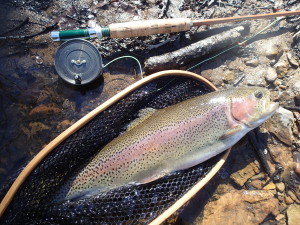
7’9″ Horrocks-Ibbotson Tonka Queen from the late 1940s to early 1950s, and Meek 55A fly reel from the 1930s.
Did I leave one major eastern company out? No, but I saved it for last: Orvis, the venerable Manchester, Vt., retail giant that has been making bamboo rods since the 1800s. From the late 1940s through the mid-1970s, Orvis made a huge number of bamboo rods, most designed by the legendary Wes Jordan, who earlier had run the rodmaking operations at Cross Rods and later South Bend after the latter company bought Cross. Orvis has diversified into clothing and country lifestyle products, but of course fly fishing remains the heart of its operations. A dwindling (now tiny) share of its rodmaking operations continues to be in bamboo, with only two or three models typically offered. But the Manchester headquarters includes the bamboo repair shop, and if you own one of the tens of thousands of cane rods the company has made, you can send it to Manchester for repair (call first, and expect a long wait — not many people at Orvis are still doing the bamboo thing). Luckily, there are so many Orvis bamboo rods out there that if you don’t want to wait for the repair, you can always buy a replacement on the secondary market. And because of the law of supply and demand, the prices are about what you would pay for upper-mid level graphite nowadays. Plus Orvis rods since the 1940s have been impregnated with Bakelite resin, which makes them pretty much bombproof — moisture and heat affect them much less than they do standard varnished bamboo rods (but don’t put them away with wet guide wraps, because the impregnation of course doesn’t include the wraps).
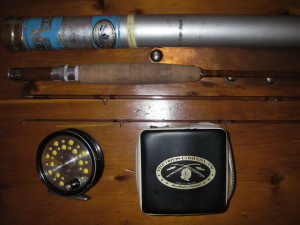
One of the most popular rods from the Orvis company is the 4 3/8 oz., 8-foot Battenkill, a versatile rod that can handle a wide range of line weights. This rod and reel were sold by Orvis, located in Manchester, Vt., in 1969.
Speaking of South Bend, the company, known mostly for its lures and lines, benefitted greatly from Wes Jordan’s tenure there. This self-trained rodmaker created the excellent Cross line of rods in the 1920s in his hometown of Lynn, Mass., and when Cross was sold to South Bend, he went along for the ride, staying in Indiana for more than a decade before being lured back to New England by Orvis. South Bend’s quality largely went downhill after Jordan left (shades of Edwards at Winchester), but there are a couple of relative gems: the 290, a two-piece 7 1/2-foot 5-weight that has a devoted following (and can be had for a bargain price, a la the Tonka Queen) and the 323, a mostly 8 1/2-footer that takes either a 5 or a 6-weight line. The rods marked HEH (the old nomenclature roughly equivalent to a DT-5) are more in demand than the HDH (DT-6), but if you want a rod for heavier trout or small bass, the HDH is great. Speaking of bass, typically a three-digit model number indicates a trout rod (323, 290,359, etc.) and a two-digit model number means a bass rod (47, 57, 59, etc.) But there are exceptions and the Cross rods have their own numbers.
Like Montague and Orvis, South Bend made so many rods that the secondary market today is full of them, and they often go at bargain prices. I used to have an 8 1/2-foot SB 57, with a cheap reel seat and suspiciously rickety-looking guides. It was ugly but powerful — as one other 57 owner said, “this rod could throw a chicken” — and I fished it in the ocean, not having to worry about damaging a valuable bamboo rod in corrosive saltwater. I landed a pretty nice schoolie striper on it in Rhode Island, and it was apparently none the worse for the wear.
Michigan was the home of James Heddon and Sons, another company that had focused on bait rods and lures but branched out into fly rods. Heddon made bamboo rods from the 1920s until the 1950s, many of them stained a distinctive rich dark brown and marked in elegant penmanship either in a spiral or a straight line, depending on the era. Finer Heddon rods were described as coming from the “hand-made department,” but even the best often had plastic reel seats that by today’s standards look cheap and fragile. However, in the 1930s through the 50s, plastic reel seats were considered exotic and advanced – and lighter than German silver or wood, not insignificant to the always weight-conscious rodmakers of that era. If you prefer, you can find rods with nice wood-inlaid seats on higher-grade rods and, oddly enough, on some “trade rods,” built like standard Heddons but marked with the names of retailers like Folsom, Weber and Lyon & Coulson. One other major distinction of Heddon’s is that the company identified its rod actions by ferrule sizes, using a number along with the suffix F. The translation from F weight to line nomenclature varies by rod length. Roughly translated, for instance, on an 8-weight rod, a 1 1/2F is a 4-weight, a 1 3/4F is a 5-weight and a 2F is a six-weight. Heddon’s top of the line rods like the Deluxe, President, and Biblically reminiscent Rod of Rods will hold their own with Leonard and Orvis rods, at least. But their most popular rod was the mid-level #17, often labeled as the Black Beauty, which came in many lengths and ferrule sizes.
Also in Michigan, Paul H. Young made an ingenious array of rods with beautifully flamed shafts, rod inscriptions that sometimes bordered on hieroglyphics, and some exotic parabolic actions. I say that because I have read it; like most bamboo rod fishers, I am vaguely aware of what a parabolic rod is but couldn’t explain it very well. It either has something to do with the rod action — the rod bending more in the tip and butt, less in the mid, or with the mathematics of its taper. They’re either very hard to cast or they cast themselves. You get the picture.
Young started out finishing his rods from blanks supplied by other companies, including Edwards and South Bend. After World War II, however, he really came into his own, creating famous tapers like the Perfectionist, the Midge, the Martha Marie (named after his beloved wife and fishing companion) and of course the Paras. Young, it has been said, was far more concerned about how a rod worked than how it looked, and his rods can look almost garage-made. But my 7 1/2-foot Martha Marie is a sublime caster. And the PHY blackened hardware over cork spacers are striking in appearance.
After Young died, his son and grandson continued making his rods. His true legacy, however, is probably held by the amazing Bob Summers, who went to work for Young as a teenager in the 50s and is today considered his legitimate heir. It’s not unusual for Summers to be asked to renovate a vintage Young rod from the 50s or early 60s that he actually worked on or built when it first came out of the shop.
Bob Summers also makes his own extremely well-regarded rods, but his wait time is such that at his age, he warns buyers, with more than a little tongue in cheek, that he may never be able to fill their orders.
From the Midwest across the Great Plains, good trout fisheries were hard to come by. That changed in Denver, gateway to the Rocky Mountains, where one of the most successful rodmaking communities in the country flourished from the Roaring Twenties through the early Cold War years.
Goodwin Granger, a Michigan native who relocated to Denver in 1908, started building rods there in 1918. Granger’s rods were at the same time delicate and powerful, suitable for both the small streams and big, windy rivers of the West.
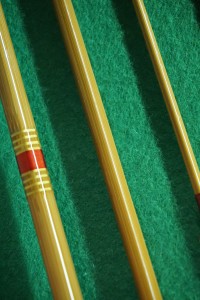
So-called signature wrap on a Goodwin Granger Colorado Special c. 1930. Each Granger grade, like models from many other makers, had a distinctive signature wrap.
In 1925, Granger hired Bill Phillipson, a Swedish immigrant and machinist who became Granger’s shop foreman. After Granger’s untimely death in 1931, Phillipson became head rodmaker at Granger. He fine-tuned the Granger tapers, developed the company’s famous locking reel seat and added new grades to the lineup. World War II halted Granger production, and at the end of the war, Phillipson tried but failed to buy the Granger company. It was sold instead to a thriving Denver tackle firm, Wright & McGill. Phillipson then founded his own company, which lasted in various forms and partnerships until his death in 1976.
Granger and Phillipson tapers are, not surprisingly, very similar. Phillipson made a variation called the Dry Fly Special, however, that surpassed contemporary Grangers in line weight, and in the early 1950s Phillipson began a transition to impregnated rods. By the mid 1950s, the impregnated rods were the only bamboo models still being made by Phillipson, who had begun developing a line of fiberglass rods. The last Phillipson bamboo rods were impregnated Peerlesses.
Wright & McGill also made an impregnated rod, the WaterSeal, based on the old Granger tapers but equipped with heavier ferrules made from Duronze.
The Duronze ferrule was featured as well on rods made by the R.L. Winston company of San Francisco. Winston was founded by and named for Robert Winther and Lew Stoner in 1929. Winther left the partnership in a few years, and Stoner patented a hollow-fluted building process in which sections of the bamboo were hollowed out to lighten the rod without weakening it. Winston relocated to Twin Bridges, Montana, in 1976. The company had branched out into fiberglass and then graphite and boron rods, but its bamboo continued to command respect in the fishing community, especially under rodmaker/owners like Doug Merrick, Gary Howells and Glenn Brackett. By 2000, Brackett had assembled a team popularly known as “the boo boys,” but in a dispute with the new owner of the company, the boys left Winston to form Sweetgrass rods. Winston continues to make fine bamboo rods under Annette McClean, but some Brackett loyalists shifted their allegiance from Winston to Sweetgrass after the falling out.
Winston was not the only company that tried to lighten the weight of its rods by hollowing techniques. E.C. Powell of California patented his own design, and he and members of his family continued to make trout, salmon and steelhead rods for decades. Early Powell rods are known for ratios of amazing power to weight, as well as for an oil finish instead of varnish. The company also made solid-built rods.
Tracing the development of American bamboo rods over the last 150 years can be perplexing, and comparisons are tricky, since factors like rod weight, the type of fish being sought, the techniques of construction, and above all the rod tapers must be accounted for. Is a delicate Paul Young Midge rod, a 6’3″ 3-weight, better than a 9′ Winston 8-weight? Only if you are going after small trout instead of steelhead. Is hollow-building critically important? Not unless you are fishing a long, heavy rod for long periods, or place a premium on quick, light-action rods not made of graphite. Should you use a heavyweight Western rod (such as a Winston or a Phillipson) on Eastern rivers? Of course, if you are casting big flies in high wind or fast, deep water or both. Can you use a delicate Catskill taper in the Rockies? Yes, if you are casting light lines for small fish.
And so on. You don’t have to drink white wine with fish or red wine with steak.
Among collectors and fishing historians, there are three major names I haven’t yet discussed — the two G’s (Garrison and Gillum), and Lyle Dickerson. They were home-workshop makers whose output came nowhere near that of the production houses or even smaller companies, and today their rods are among the most sought-after and valuable of the Golden Age.
Their tapers are ubiquitous, among basement builders and major names in the craft (the two categories are not mutually exclusive).
Lyle Dickerson built a variety of crisp dry fly rods that are widely imitated today. From 1931 to 1972, Dickerson handcrafted his rods, including the famous 8013 (the numbers refer to the length of the rod, 8 feet, and the size of the ferrule, 13/64 of an inch.
Harold “Pinky” Gillum had trained under Edwards before going out on his own. Gillum, who had a reputation for crankiness – the story goes that he refused to repair rods that he believed had been carelessly damaged, and that he once repossessed a rod on the stream from an owner he thought was abusing it – was a perfectionist who demanded the best not only from himself but from the buyers of his rods. His rods are known for their power and straightforward appearance – and for their collectibility. Gillum’s rod output over about 40 years has been estimated at 1,000 to 2,000, and they have been known to sell for up to $20,000 in recent years. Some critics have been puzzled by the demand, claiming that Gillum’s rods lacked the finesse and fineness of rods by Payne and other makers, but there you have it.
The reason for Garrison’s enduring fame is not hard to understand. Everett Garrison (1893-1975) was a trained engineer who segued into rodmaking through a combination of golf and geography. Garrison was a golfer who became interested in bamboo in part because he wanted to improve on golf club shafts (he also was acquainted with George Parker Holden, author of “Idylls of a Split Bamboo.”) Garrison, who lost his job as an engineer in the Great Depression, turned to rodmaking, and even after returning to his profession, he continued to pursue his new interest. Because many of the early and even later rodmakers came up through the apprentice system, or were self-trained entrepreneurs, Garrison’s scientific methods attracted attention. His fame continued — some might even say it grew — after his death, when he was credited as the co-author with Hoagy B. Carmichael of “A Master’s Guide to Creating a Bamboo Fly Rod.”
Hoagy Bix Carmichael’s father was Hoagland “Hoagy” Carmichael, composer of “Stardust,” “Georgia on My Mind,” “Heart and Soul” and of course “Up the Lazy River.” But Hoagy Bix, named for his father’s best friend, the jazz trumpeter Bix Biederke, says his father was not a fisherman. Hoagy Bix Carmichael was a successful television producer (“Mr. Rogers”) who met Garrison on a fishing trip, and, interested in learning how to make a bamboo rod, began to study under Garrison. Carmichael made a videotape of Garrison creating bamboo rods in the 1970s, and proposed to his mentor that they write a book detailing the steps. After Garrison died, Carmichael, with the permission of Garrison’s widow, obtained Garrison’s rodmaking shop and completed “A Master’s Guide.”
The book, published in 1976, was so influential that it became known among basement and garage bamboo fly rod builders as “the Bible.” The impact of the book is itself a topic of historical debate. Some rodmakers and collectors assert that the book makes the rodmaking process sound far more complex than it actually is, and resent the popular belief that bamboo rodmaking was a lost art until Carmichael published the book — companies like Orvis, Winston and Leonard, after all, had never stopped making bamboo rods, nor had the age of fiberglass and graphite meant the end of basement-garage bamboo craftsmen. The book, of course, never made either of these assertions.
Hoagy Carmichael made a very small number of rods – a little over 100 — based on Garrison tapers before turning his attention to writing and managing his father’s musical legacy. His rods are rare and very valuable.
During World War II, military needs forced many civilian products to the side of the road. The government regulated materials and production, and some rod and reel companies shut down either because they had to or because they refocused on military demands. Rodmakers like Bill Phillipson, Jim Payne and Gene Edwards went to work in factories making war supplies. Orvis made bamboo ski poles for Army alpine troops.
After VJ-Day, the fishing industry eagerly retooled, anticipating huge demand as the millions of Americans in uniform came home and sought peace in the solace of the stream. But the relentless technological advances of wartime had brought many changes, including the development of fiberglass. Glass rods would be lighter than bamboo, and most importantly, cheaper.
The next blow to the industry resulted from the Communist victory in the Chinese civil war, and the subsequent Red Chinese intervention in the Korean War. An embargo on the Chinese Tonkin cane that was state of the art in bamboo production then and now sent the bamboo rod world into a tailspin. Granger, Thomas, the Edwards brothers, Heddon, South Bend, and other companies either switched to glass or went out of business. Phillipson and Leonard did both.
But Winston and Orvis survived, and a new company improbably begun in the 1970s not only took root but flowered — Thomas and Thomas, named for its founders, Tom Dorsey and Tom Maxwell, who began their enterprise as college students in Maryland. The company grew and moved to Greenfield, Mass., where it acquired the stock and rodmaking equipment of the Sewell Dunton company, itself the last incarnation of the old Chubb-Montague line. T&T, as it is popularly known, became famous for rods with crisp progressive tapers, swelled butts and rich finishes, both varnished and impregnated. Maxwell left the company and went to work for Leonard before he died. T&T has changed hands a few times, but Dorsey remains, and the new management says that it is deeply committed to matching the quality of the company’s glory days.
No bamboo operation existing today comes close to matching the production output of the big rod companies of the golden age, nor is it likely that any ever will. How could they? Most people who buy fly rods want graphite, not bamboo. But Sweetgrass Rods, Winston and even smaller operations like the A.J. Thramer Bamboo Rod Co. in Oregon are credited with relatively robust production numbers. Add the large remaining stock of vintage rods and a growing pool of very talented modern craft rodmakers, and it appears that the supply of classic rods is healthy enough for the demand.
It is often said that the great craftsmen who made the classic rods of the Golden Age of angling had little or no interest in “legacy,” that they just wanted to make the best fish-catching tools possible, and that they would be astounded by the prices some of their work commands today. That may well be true, but I think they would also be pleased that their rods are still out on the water. Fishing with those rods honors them and their work.
Sources: “Classic Rods and Rod Makers” by Martin J. Keane, “Classic and Antique Fly Fishing Tackle: A Guide for Collectors and Anglers,” by A.J. Campbell; “Rod-Crafting,” by Jeffrey L. Hatton, “Goodwin Granger, the Rod Man From Denver,” by Michael Sinclair; “Colorado Classic Cane,” by Dick Spurr and Michael Sinclair; “Heddon, the Rod With the Fighting Heart,” by Michael Sinclair, “8 by Carmichael,” by Hoagy B. Carmichael, “Jordan, the Rodmaker,” by William H. Jordan; “Dickerson, The Man and His Rods,” by Gerald S. Stein and James W Schaaf; “Playing With Fire: The Life and Fly Rods of E.W. Edwards,” by Patrick Garner; “D Is for Dingley: The Master Reelmaker,” by Patrick Garner and Brian Taylor; plus countless posts and topics on the Classic Fly Rod Forum, especially the “rodmakers history and value guide” by Sante Giuliani (Fishnbanjo), a former owner of the forum.
